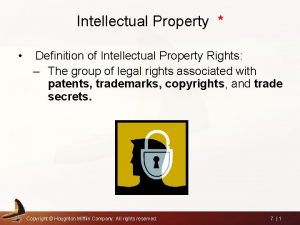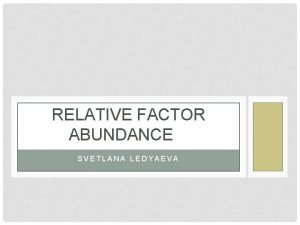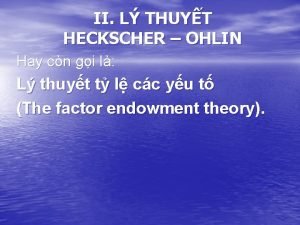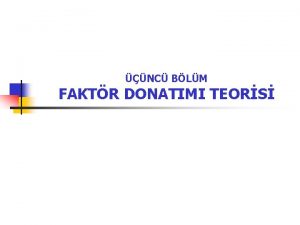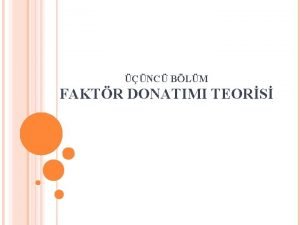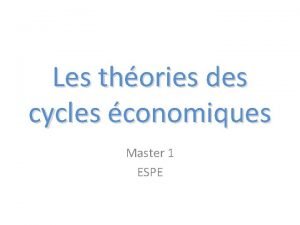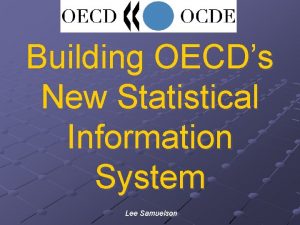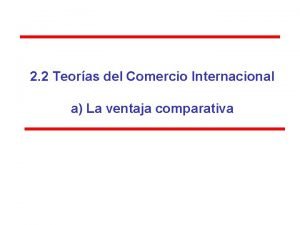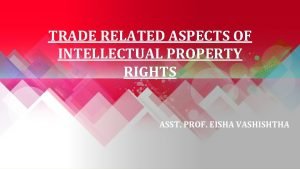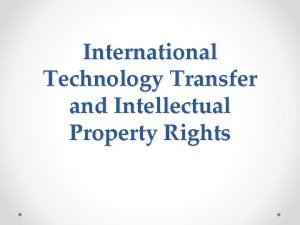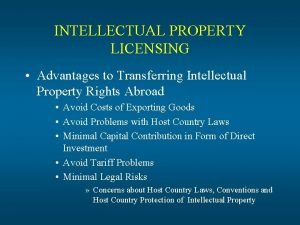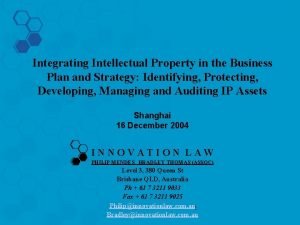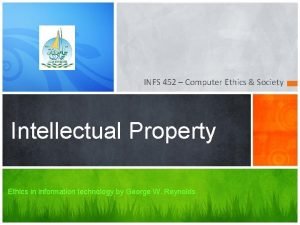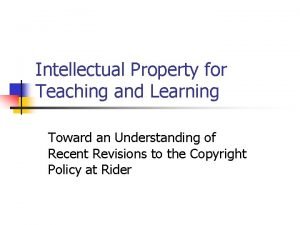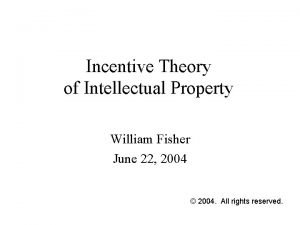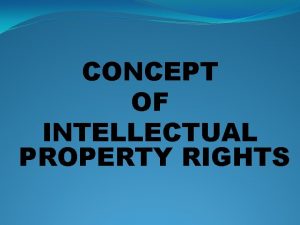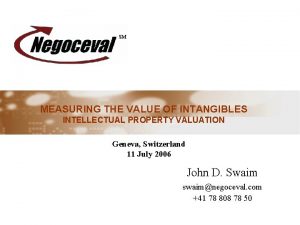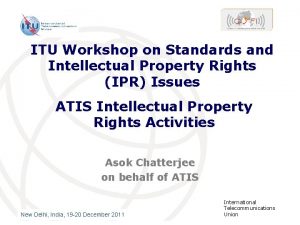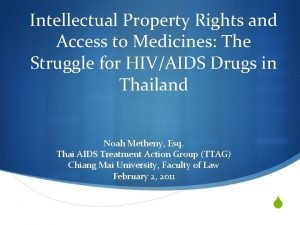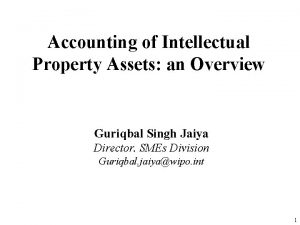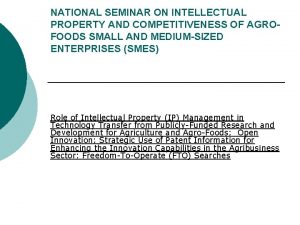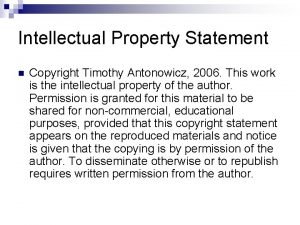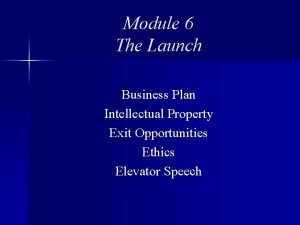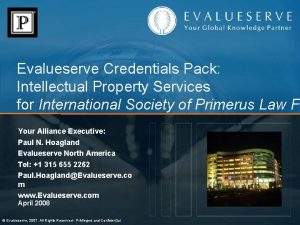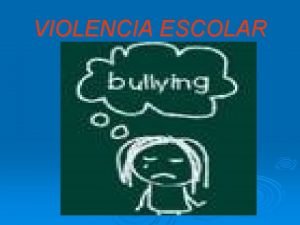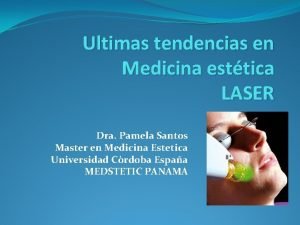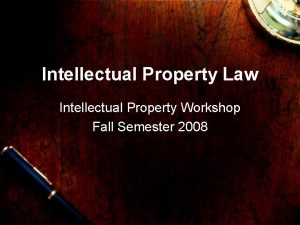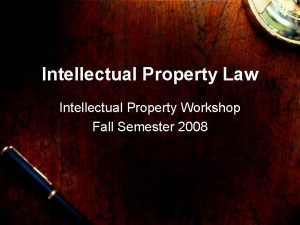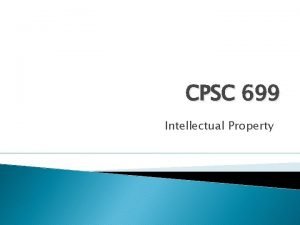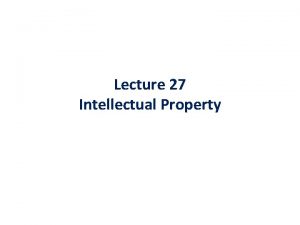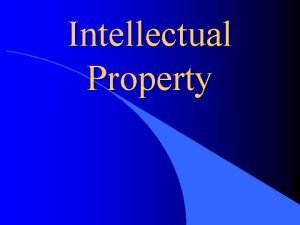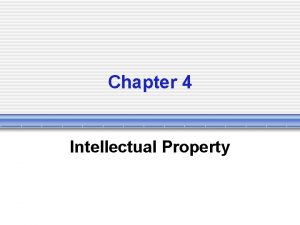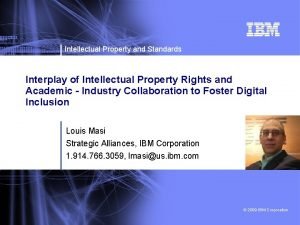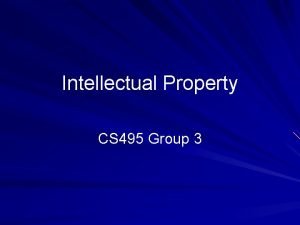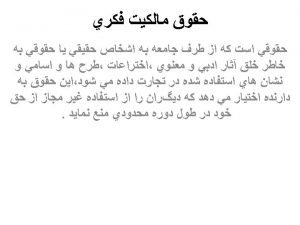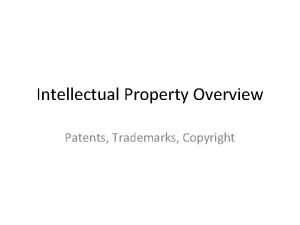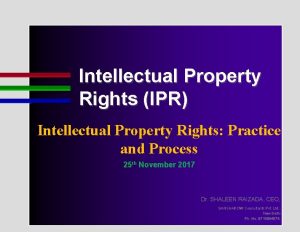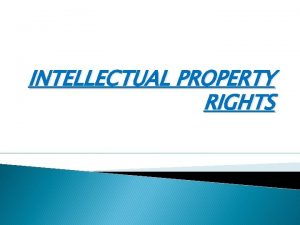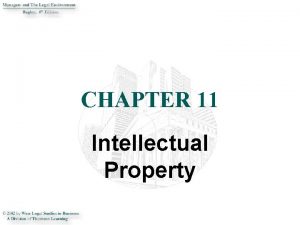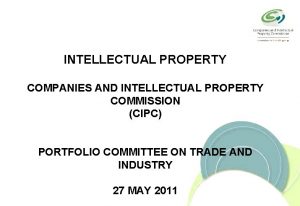TUTORIAL ON INTELLECTUAL PROPERTY LAW Pamela Samuelson David






































- Slides: 38

TUTORIAL ON INTELLECTUAL PROPERTY LAW Pamela Samuelson & David Post Computers Freedom & Privacy April 4, 2000 1

OVERVIEW • Samuelson will do: – Overview on intellectual property & its purposes – Basics of copyright, emphasizing digital copyright issues – Basics of trade secrecy and De. CSS case • Post will do: – Trademark & domain name disputes – Patents for software & business methods 2

WHAT IS “IP”? • Intangible rights in commercially valuable information permitting owner to control market for products embodying the information • Copyrights for artistic & literary works • Patents for technological inventions • Trade secrets for commercially valuable secrets (e. g. , source code, Coke formula) • Trademarks (e. g. , Coke) to protect consumers against confusion 3

ELEMENTS OF IP LAW • Subject matter to be protected • Qualifications for protection – Who can claim – Procedure for claiming – Substantive criteria • • Set of exclusive rights Limitations on exclusive rights Infringement standard Set of remedies 4

DIFFERENT THEORIES • Utilitarian: grant rights to create incentives for beneficial investments • Natural rights: persons have natural rights in their creations if valuable • Personality-based: my creation is an extension of myself • Unjust enrichment: appropriating someone else’s work may be unfair 5

ELEMENTS OF COPYRIGHT • Subject matter: works of authorship (e. g. , literary works, musical works, pictorial works; NB: software is a “literary work”) • Qualifications: – Who: the author (but in US, work for hire rule) – Procedure: rights attach automatically (but US authors must register to sue; remedies depend on regis. ) – Criteria: “originality” (some creativity); in US, works must also be “fixed” in some tangible medium 6

COPYRIGHT ELEMENTS (2) • Set of exclusive rights (right to exclude others) – – to reproduce work in copies, to prepare derivative works, to distribute copies to the public, to publicly perform or display the work, or communicate it to the public – “moral rights” of integrity & attribution (US visual art) – some rights to control acts of those who facilitate or contribute to others’ infringement (e. g. , ISPs, agents) 7

COPYRIGHT ELEMENTS (3) • Limitations on exclusive rights: – – – Fair use (e. g. , Sony Betamax, Acuff-Rose) in US Fair dealing in UK and Canada First sale (e. g. , libraries, bookstores) Library-archival copying (e. g. , ILL, course reserves) Classroom performances Special inter-industry compulsory licenses (e. g. , cablenetwork TV) – Other (e. g. , playing radio in fast food joint) 8

COPYRIGHT ELEMENTS (4) • Limitations on exclusive rights: duration – Berne standard: life + 50 years – EU & US: life + 70 years; 95 yrs from publication • Infringement standard: violating exclusive right (often copying of “expression” from protected work based on substantial similarity) • Remedies: injunctions, lost profits, infringers’ profits, “statutory damages, ” costs, & sometimes attorney fees 9

“UNCOPYRIGHTABLE” STUFF • • Ledger sheets and blank forms Rules and recipes (“merger”) White pages listings of telephone directories Facts and theories Ideas and principles Methods of operation/processes Bicycles and bicycle racks (too functional) 10

COMPILATIONS AND DERIVATIVE WORKS • Creativity in selection and arrangement of data or other elements = protectable compilation • Original expression added to preexisting work = protectable d/w (e. g. , novel based on movie) • Compilation or derivative work copyright doesn’t extend to preexisting material (e. g. , data or public domain play) • Use of infringing materials may invalidate copyright in compilation or derivative work 11

INTERNATIONAL TREATIES • Berne Convention for Protection of Literary & Artistic Works • Basic rule: “national treatment” (treat foreign nationals no worse than do own) • Berne has some minimum standards (duration, exclusive rights, no formalities) • WIPO administers treaties, hosts meetings to update, revise, or adopt new treaties 12

INTERNATIONAL TREATIES (2) • TRIPS (Trade-Related Aspects of Intellectual Property Rights) Agreement • Sets minimum standards for seven classes of IPR, including copyright, that binds WTO members • Must have substantively adequate laws, as well as adequate remedies and procedures and must enforce effectively • Dispute resolution process now available (e. g. , EU challenge to US music licensing exception) 13

DIGITAL COMPLICATIONS • Digitized photographs of public domain works (e. g. , Microsoft claims ownership in some) • Very easy to reselect and rearrange the data in databases; uncreative databases may be very valuable; EU has created a new form of IP right in contents of databases to deal with this • New ways to appropriate information (e. g. , NBA sued Motorola for “stealing” data from NBA games for sports pager device) • Digital environment lacks geographic boundaries 14

DIGITAL COMPLICATIONS (2) • Can’t access or use digital information without making copies • Very cheap and easy to make multiple copies and disseminate via networks • Very easy to digitally manipulate w/o detection • People expect digital information to be free or nearly so • Many people think that private copying doesn’t infringe copyright; much of industry disagrees 15

DIGITAL COPYRIGHT CONTROVERSIES • • Linking, framing, & filtering i. Crave. TV case Cyberpatrol case RIAA v. Diamond (Rio player case) UMG Recordings v. MP 3. com Napster case De. CSS cases 16

US WHITE PAPER ON IP & THE NII (1995) • Full potential of NII won’t be realized unless IP/copyright owners are adequately protected • Many are withholding works from the ‘net because of threat of piracy • Copyright can be adapted to digital environment, need a few changes 17

WHITE PAPER POSITIONS • Authors have right to control temporary copies in RAM (reading or browsing as infringement? ) • Fair use should recede (if work can be licensed, it must be licensed) • No more first sale/sharing rights (first sale only permits redistributing same copy, not making new ones) • ISPs should be held strictly liable for user infringements 18

WHITE PAPER POSITIONS • Need for new rules to make it illegal to remove or alter copyright management information (CMI) • Need to outlaw technologies useful for bypassing technical protection systems • Get international treaty to universalize these new norms 19

WIPO COPYRIGHT TREATY (1996) • Reproduction right applies to digital works (but no agreement on temporary copies) • Exclusive right to communicate digital works to the public by interactive service • Fair use and other exceptions can apply as appropriate; new exceptions OK • Merely providing facilities for communication not basis for liability 20

WIPO TREATY (2) • Tampering with copyright management information to enable or conceal infringement should be illegal • Need for “adequate protection” and “effective remedies” for circumvention of technical protection systems • Treaty not yet in effect, but US has ratified; EU in process of implementing; Canada has signed 21

DMCA • Digital Millennium Copyright Act (1998) • “Safe harbor” provisions for ISPs – Transitory network communication – System caching – User-stored information – Information location tools • Section 1201: anti-circumvention rules • Section 1202: false CMI/removal of CMI 22

DMCA ANTICIRCUMVENTION RULES • Treaty very vague; unclear what’s required • Campbell-Boucher bill in US: proposed to outlaw circumvention of TPS to enable copyright infringement • MPAA: wanted all circumvention outlawed • Compromise in DMCA: illegal to circumvent an access control, 17 U. S. C. s. 1201(a)(1) • But 2 year moratorium; LOC study; 7 exceptions 23

EXCEPTIONS TO CIRCUMVENTION RULE • Legitimate law enforcement & national security purposes • Reverse engineering for interoperability • Encryption research and computer security testing • Privacy protection & parental control • Nonprofit “shopping privilege” 24

ANTI-DEVICE PROVISIONS • Illegal to “manufacture, import, offer to public, provide or otherwise traffic” in • Any “technology, product, service, device, [or] component” • If primarily designed or produced to circumvent TPS, if only limited commercial purpose other than to circumvent TPS, or if marketed for circumvention uses 25

MORE ON DEVICE RULES • 1201(a)(2)--devices to circumvent effective access controls • 1201(b)(1)--devices to circumvent effective controls protecting right of cop. owners • Actual & statutory damages + injunctions • Felony provisions if willful & for profit • MPAA v. Reimerdes 1 st civil case 26

CURIOUS THINGS ABOUT 1201 • Only 3 exceptions to 1201(a)(1) explicitly allow building tools • Only interoperability exception limits both anti-device rules • Did Congress mean to allow circumvention to make fair use, yet make it illegal to make tools needed to accomplish? (Ha! Ha!) • LOC to study only act, not device rules 27

PROBLEMS WITH A/C REGS • Legitimate purpose circumventions – existing exceptions overly narrow – need for general purpose exception – clarify that fair use circumvention is OK • “Dual use” technologies – tools to enable legitimate uses – how device rules could be narrowed • Copyright-centric regulations 28

EXCEPTIONS TOO NARROW • Interoperability: not just programs; other reverse engineering may be legitimate • Encryption and computer security research: – no authorization and expert requirements – OK to make tools – less onerous rules on disseminating results • Privacy exception: Windows 2000 hypothetical 29

A GENERAL PURPOSE EXCEPTION? • Need for “or other legitimate purpose” exception to access control rule • Examples of other legitimate acts: – if reasonable grounds to believe infringing copy or computer virus inside TPS – illegitimate invocation of “technical self-help” • Courts able to tell difference between legitimate & illegitimate acts 30

DUAL USE TECHNOLOGIES • Circumvention tools are not burglars’ tools • Ways to narrow rules: – substantial noninfringing use standard – intent/knowledge/injury/infringement requirement – commercially significant cf. apparent legitimate purpose (freeware should not be vulnerable) – technology-specific (e. g. , circumvention of SCMS) • Think through relation between range of legitimate circumventions and availability of tools (if X is lawful, tool to do X should be OK) 31

COPYRIGHT-CENTRICITY • Encryption protects more than commercial copyrighted products (e. g. , private personal communications, trade secret/confidential business information, e-cash) • Circumvention of encrypted information is a more general problem (sometimes legitimate, sometimes not) • So is the availability of circumvention technology • Would suggest the need for a general law 32

UNINTENDED CONSEQUENCES? • X makes software that circumvents Y’s encryption system • Z is a copyright owner who decides to use Y’s encryption system to protect digital pictures • Does X’s tool then become illegal? • Can Y sue X? Can Z sue X? What harm has X’s software done to Y or Z? • 1201 (a)(2) and (b)(1) does not require any underlying infringement; mere potential is enough 33

MPAA v. REIMERDES • Injunction vs. posting of De. CSS on websites or otherwise making it available • CSS is effective access control for DVDs • De. CSS circumvents it & has no other commercially significant purpose • Lack of evidence for Linux compatibility argument • Besides, 1201(f) only protects interoperation with “programs, ” not “data” on DVD 34

ELEMENTS OF TRADE SECRECY • Information that can be used in business that is sufficiently valuable & secret as to afford an economic advantage to the holder • Outgrowth of unfair competition law • No “exclusive rights” as such, but protected vs. use of improper means & breach of confidence • Independent development & reverse engineering are legitimate ways to acquire a trade secret • Relief generally limited to period in which independent development would have occurred 35

DVD-CCA v. Mc. LAUGHLIN • Trade secret misappropriation case • CSS = proprietary information; DVD-CCA took reasonable steps to maintain secret • Inference: someone must have violated clickwrap license forbidding reverse engineering • Breach of agreement was improper means • Even though De. CSS on web for 4 months, not to enjoin would encourage posting TS on Web • Judge upset by “boasting” about disrespect for law 36

IMPLICATIONS OF DVD-CCA • Anti-reverse engineering clauses are common in software licenses; enforceability much debated • Judge’s willingness to enforce and treat information obtained through reverse engineering as trade secret worrisome • Judge’s willingness to enjoin information that had been public for several months may be error • “Fruit of poisonous tree” rationale (judge knows Johansen didn’t reverse engineer, nor did many posters, yet held as trade secret misappropriators) 37

CONCLUSION TO PART I • Digital technology has posed many difficult questions and problems for copyright law • Much remains in controversy; how current cases are resolved matters a lot • Possible to build balance into law, but US “selling” broad anti-circumvention rules • Gap in perception about law as between copyright industry and the public; enforceability & respect for law contribute to difficulties • Easier to see the risks than the opportunities 38
 Intellectual property law definition
Intellectual property law definition Stolper samuelson theorem
Stolper samuelson theorem định lý stolper-samuelson
định lý stolper-samuelson Leontief teoremi
Leontief teoremi Teors
Teors Oscillateur samuelson
Oscillateur samuelson Lee samuelson
Lee samuelson Modelo heckscher-ohlin ejemplo
Modelo heckscher-ohlin ejemplo Trade related aspects of intellectual property rights
Trade related aspects of intellectual property rights Secondary infringement
Secondary infringement Importance of intellectual property
Importance of intellectual property Intellectual property management definition
Intellectual property management definition Advantages of intellectual property
Advantages of intellectual property Intellectual property business plan
Intellectual property business plan Property
Property Right to intellectual property of teachers
Right to intellectual property of teachers Incentive theory
Incentive theory Concept of intellectual property
Concept of intellectual property Intellectual property valuing
Intellectual property valuing Intellectual property rights
Intellectual property rights Intellectual property rights
Intellectual property rights Characteristics of intellectual property
Characteristics of intellectual property Discuss intellectual property frankly
Discuss intellectual property frankly Sfas 142
Sfas 142 Intellectual property
Intellectual property Intellectual property statement
Intellectual property statement Intellectual property business plan example
Intellectual property business plan example Evalueserve intellectual property
Evalueserve intellectual property Discuss intellectual property frankly
Discuss intellectual property frankly At&t ecommerce
At&t ecommerce Newton's first law and second law and third law
Newton's first law and second law and third law Si unit of newton's first law
Si unit of newton's first law Boyle's law charles law avogadro's law
Boyle's law charles law avogadro's law Charles law constant
Charles law constant Commutative vs associative
Commutative vs associative Classification of property under hindu law
Classification of property under hindu law Physical and chemical properties
Physical and chemical properties Triangulo del bullying
Triangulo del bullying Dra pamela santos
Dra pamela santos
